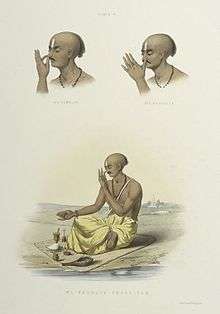Kumbhaka
Definition

Kumbhaka is the pause between an inhale and exhale. According to B.K. S. Iyengar in Light on Yoga, the "retention or holding the breath, a state where there is no inhalation or exalation".[1] Mr. Iyengar also notes that in some yoga texts the term is used generically to indicate all three parts of the breath: inhale, exhale, and pauses. Along with the inhale and exhale, the kumbhaka is essential to any practice of pranayama. To further clarify the teachings of pranayama the khumbhaka which follows the inhale is called the bahya kumbhaka and that which follows the exhale is called the antara kumbhaka. (Bahya means outer/exterior. Antara means inner/interior.[1])
| Name | Definition |
|---|---|
| Antar Kumbhaka | It is ceasing of breath when the inhalation (or Poorak) is complete and the lungs are filled up with air. In this kumbhaka, inhalation is recommended to be slightly forceful to take more air than normal and ceasing it as per one's ability. |
| Bahya Kumbhaka | It is ceasing of breath when the exhalation (or Rechak) is complete. It is also recommended to exhale more than normal and then cease it as per one's ability. |
| Sahit Kumbhaka | It is the kumbhaka performed with inhalation or exhalation. |
| Kevali Kumbhaka | Inhalation or exhalation is not required or not focussed in exercising Kevali Kumbhaka. It is the extreme stage of Kumbhaka which is attained only by continuous long term pranayama and kumbhak exercises. |
Importance
Respiration includes inhalation and exhalation. In between these two processes there is a very minute gap or pause (normally in milliseconds) which is usually not noticed and it recurs, i.e., inhalation-pause-exhalation-pause-inhalation.... and it continues. The maximum gap or pause is observed in the state of rest. Kumbhak enforces to increase the pause by ceasing the breath routinely and continuously by various types of pranayama and kumbhaka exercises.
It has been said that It is being observed that the more time spent for pranayama (and kumbhaka); the more is the concentration and the better is the control over mind. Various ancient yogis (expert in yoga and pranayama) noticed the importance of respiration and its correlation with activities of mind and vital forces. Aging is also seen proportional to frequency of respiration or respiratory rate, i.e., frequency of inhalation and exhalation in one minute. Medical science recorded normal respiratory rate in humans as 12-16 breaths per minute with life span of 70–80 years. These figures may vary due to geographical, communal and other distribution factors.
Immortality
Aging is proportional to respiratory rate (excluding exceptions), e.g.,
- Mouse: Respiratory rate = 60–230/min and Life span = 1.5–3.0 years
- Rabbit: Respiratory rate = 30–60/min and Life span = 5.0–6.0 years
- Monkey: Respiratory rate = 30–50/min and Life span = 20–30 years
- Human: Respiratory rate = 12–16/min and Life span = 70–80 years
- Whales: Respiratory rate = 3–5/min and Life span = more than 100 years
Though the level of consciousness varies from species to species, it is seen highest in humans where conscious mind can provoke to perform activities and exercises as per wishes and this voluntary performance is not up to such an extent in any other species and consequently all other species cannot cease their breath as and when desired (voluntarily). Some species (e.g., whales) can take enormous air and cease it for a long time but that is spontaneous requirement and involuntary; and it is the necessity for them to survive this way.
Practicing kumbhaka for a long time increases endurance of physiological as well as psychological structure of an individual. Continuous and long term practicing increases the hold or control on breath up to an extent where it reaches to its extreme stage (Kevali Kumbhak) and the respiration is ceased permanently unless desired to get into normal state.
Aging is proportional to metabolism which in turn is proportional to respiratory rate. Metabolism lowers down as the respiratory rate decreases and this helps prevent aging or at least lowers down the process. It has not been recorded scientifically whether kevali kumbhaka can increase age (or can make immortality a fact) by lowering down the basic reactions which support life, however, various yoga sutras and religious scriptures define samadhi and immortality an approachable aspiration for determined individuals. [citation needed]
See also
- Yoga
- Pranayama
- Hatha yoga
- Raja yoga
- Upanishads
- Immortality
- Mind
- Respiration (physiology)
- Control Pause